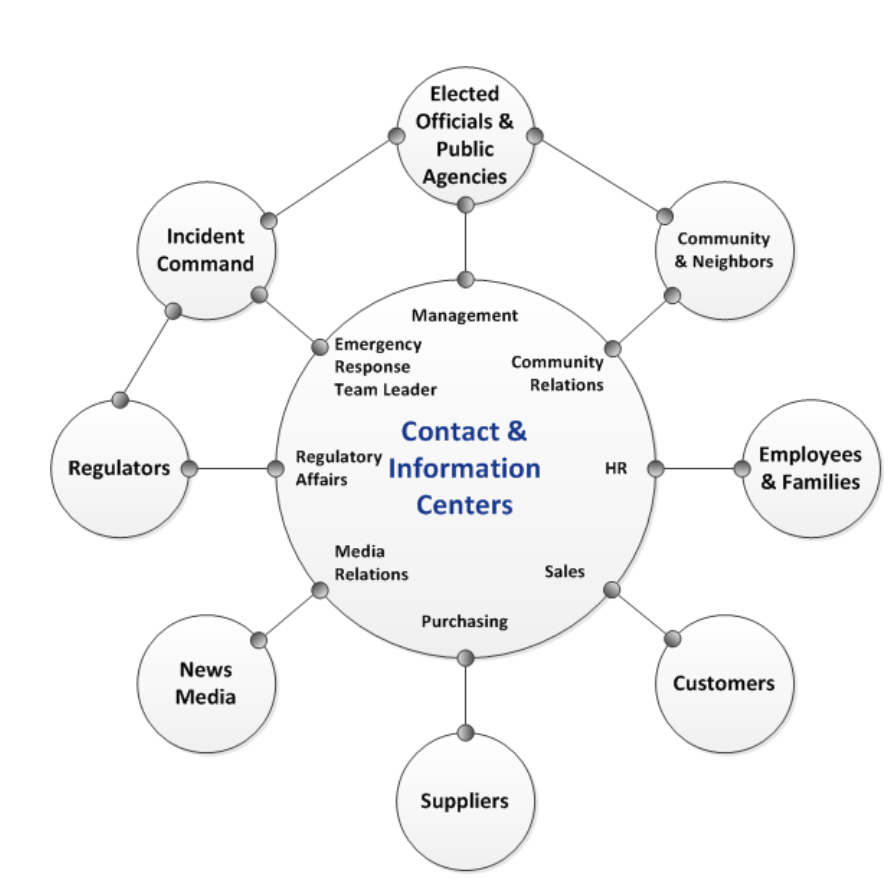
By Joe Curley, APR, CPRC
Each crisis is an individual living/breathing event and no two are alike. The hundreds of possible elements and combining circumstances dictate how each crisis unfolds and runs its course. These variables demand that we must be prepared to have flexible planning abilities and modify actions, strategies and tactics on-the-fly to stay ahead of the ever-changing factors of a given crisis.
To keep PR staff on point, we need to develop a written Emergency Crisis Communications Plan in advance. The plan will never accurately track all the unknown and moving parts of the crisis, but the plan will serve to keep us thinking straight and provide a guideline and checklist of the necessary steps and actions we need to follow to best manage the situation.
As I drafted this White Paper, I wanted to make it short, concise and easy to remember and had a working title “The 7 C’s of Crisis Communication.” But similar to an actual crisis, I had to change my planning as many new plan elements kept coming up that needed to be included, which resulted in more C’s than I have counted and ever used in a single document. Crises (I had no idea of the spelling for the plural!) are just that way, too … everchanging.
Let’s start examining the ocean of C’s that guide your behaviors, messages and actions at the onset of a crisis, and then we’ll look at some basic elements of a written Emergency Crisis Communications Plan.
The 7 C’s of Crisis Communications – (Actually many, many C’s)
1. Calm, Competent and Contextual
From the minute tragedy strikes, you and your crisis team must remain calm and clearheaded, this is not the time to panic or display off-the-cuff actions. The early period of a crisis will set the stage with the media and your target audiences on how candid, capable, and credible your company is acting.
2. Communicate Circumstances with Compassion
Demonstrate your knowledge of the issues and deep concern for those affected. Focus on known facts and avoid all speculation and never provide specific measurements of damages (that will come in the follow-up remediation stages). Don’t be afraid to “Confess,” Comply or Concede if the issues warrant. You may have to battle your lawyers on this one, but the public respects facts and honesty and grandstanding denials will not eliminate liability nor help preserve your company reputation, which is at stake here.
3. Commitment to Communicate and Correction
Pledge to solving the problem and preventing it from happening again. This can include immediate real-time steps to mitigating its effects and plans for future prevention remediation. Be sure to include legal and risk-management departments.
4. Clear and Consistent (messaging)
Develop message points that are easily understood by the general public and avoid industrial jargon and deep details that distract from communicating short, factual, understandable messages. Keep these message points absolutely consistent with all top management, legal, employees, stakeholder audiences and of course, the news media. Keep message points consistent when delivering variations of the messages to different stakeholder audiences as media will have sources to access all company message viewpoints. See diagram below as a guideline to reaching stakeholder audiences.

5. Competent and Credible Spokesperson
Spokesperson selection should be done well in advance as a part of the planning within the company crisis plan. The spokesperson must have an excellent grasp of the situation and clearly impart to the media and public that they “get it.” This builds confidence with all audiences. Do not use the “boss” just because he/she is the boss if they are not competent and credible spokespersons. Also decide whether to “present or protect” top management during a crisis. News media tend to judge the severity of a crisis by the level of spokesperson executives, so don’t elevate the situation with the president when a mid-level operation executive is best suited for the particular crisis.
6. Continued Communication and Caring
Throughout and after the crisis is resolved, continue to communicate to the news media and stakeholder audiences the current facts and continuing prevention remediation plans. Create a media log to identify media inquiries and who responded to them. The media, general public and stakeholder audiences must perceive that your company grasps the situation and is capable of solving the problems.
7. Cleanup and Consensus
After the crisis is over, conduct a research survey with media, community leaders and the business community and effected audiences to measure a “how did we do” benchmark. Use these data to decide if further crisis event action is required and also to make modifications to the company’s crisis communication plan from the “lessons learned.”
An Overview of the Basic Elements of an Emergency Crisis Communications Plan:
I hope you have all those C’s digested, as now we move on to some basics to help you get started with writing a plan down on paper.
- An Emergency Crisis Communications Plan should include the following basic elements (plus many, many more customized to your corporate requirements):
- A swift response to media and stakeholder audiences is essential and executive management (including the legal and risk-management departments) must be kept apprised of the on-going crisis elements and PR actions. Less detailed reports should be delivered to employees and stakeholders. Setting up a “dark website” in advance should be considered and used for internal executive staff communication and timely notice of actions and change.
- Establish an Emergency Communications Director (ECD) position that has across-the-board authority to directly request help from other corporate departments for services/goods/staffing necessary to provide support for victims, emergency workers and PR staff, etc. For example, needs may include additional secretarial staffing, cafeteria food/beverage services, additional security, transportation vehicles and merchandising assistance for blankets, clothing, foul weather gear, etc. This ECD position is an “unfilled” and temporary position that commences with the crisis and ends when the crisis is over, but is endowed with “CEO-like authority” to instantly command requests from all departments and divisions companywide without red-tape, delays or regard to budget to help support the needs to manage the crisis. The first PR team responder will take on the role of ECD until more senior PR staff arrive (consulting by phone until their arrival), who then assume the ECD role. This ECD slot helps to assure swift and rapid proactive actions in the early crisis minutes and during the hours the crisis begins to unfold.
- Have a phone/email list of all PR staff, executive management, operations management and facilities management. This should include heads of government (city/county/state), regulating agencies and police/fire/EMS contacts as well as adjacent neighborhood Homeowners Associations contacts and management of nearby businesses. Also have an “information blast” system (phone or text or social media) set up to deliver facts/data/updates to entire group lists of selected executive management and other significant stakeholders.
- Develop a crisis-specific question and answer statement for use by PR staff and designated spokespersons for a response guide to media inquiries. This needs to be updated as the crisis unfolds.
- Only designated spokespersons will be the individuals to make statements to news media or other stakeholder audiences on behalf of the company.
- Names of injured or dead will not be discussed or released by the corporation, but rather by appropriate law enforcement agencies. Sensitive information (deaths, injuries, etc.) should not be relayed by two-way radio or cell phone, as these channels may be monitored.
- The EDC has the immediate power to purchase commercial radio/TV/newspaper advertising space as well as posting (buying space too) on selected social media platforms, for means of communication to public, employees and/or stakeholder audiences.
- Create an “emergency information page” on your website and keep this informational page updated on a timely basis (facts of the crisis, employee work notices, parking lots/roads closed, etc.). Be aware a crisis can create a huge volume of additional website hits that can cripple your main website. Investigate your company website’s ability to handle a “high hit” situation and if necessary, build in an element to handle a potential onslaught of on-line inquiries.
- Establish restricted responses, access, and actions:
- At no time are the media to be allowed to enter any on-property crisis scene unless approved and escorted by corporate PR staff.
- No dollar damage estimates, or cause of blame will be reported until investigated, appraised and approved by appropriate company officials, including law and risk management departments. Do not comment on estimates/blame that may be reported by police, fire, hospital, etc. Send media back to the source for additional comment.
- Employees must be prohibited from taking live video or still photography of on-site crisis events for distribution to any person or any entity other than corporate executive staff for the purpose of determining cause/effect and remedial actions. This restriction should be it the “employee contract” signed at the time of hire.
- Actions as the Crisis Unfolds:
- Strive for timely, consistent, and candid flow of accurate information to the media, executive staff, the public, employees and stakeholder audiences. While these message points may vary to these targeted audiences, be aware that media have sources to garner copies of all out-bound corporate communications.
- All outbound information and messages must be truthful and include full disclosure, even if some data aren’t (fact: data is plural) glowing for your corporation. Getting the entire story out quickly reduces the cycle of media digging for additional facts and keeping the issues in the news. This is the high-road approach and will compress the news cycle and set a good foundation to protect the corporate reputation.
- Have corporate communication sources open 24/7 during the hours or days following the crisis situation to respond to incoming inquiries.
- Set a goal –based on achieved control of the crisis– for when you will cut back on public/stakeholder statements and work toward moving the story off Page One by maintaining your policy of complete and honest disclosure.
- Don’t allow the entire corporation to become consumed with the on-going crisis. Regular day-to-day business operations must continue as normal as possible (given some operational modifications due to interfering crisis effects.)
- Create a media inquire log to keep track of media questions and company responses. This should include time/date of call and name of staffer who responded, and details of data exchanged.
- After-Crisis Evaluation:
- In the aftermath, reconvene the PR/Executive crisis team to evaluate actions and identify areas of concern. Likewise, conduct a research survey of community publics, businesses, government leadership and stakeholder audiences to gauge “how did we do” and use the combined data to make changes to the crisis plan structure and actions.

About the Author:
Joe Curley, APR, CPRC, has practiced public relations in Florida for more than 40 years and is now semi-retired. He was the co-founder and president of one of Florida’s largest PR firms, Curley & Pynn Public Relations Management in Orlando, which he sold in 2004 and is still in full operation.
Joe’s PR experience spans nearly all business market segments including aerospace, travel & tourism, real estate, professional services (law/accounting/medical), as well as urban development, construction and housing. Joe has extensive PR planning, crisis and international PR experience, is a requested speaker and has won countless PR awards.
Currently a public relations and marketing consultant at his own firm Stingray Solutions, Inc., Joe was retained by Universal Studios Parks & Resorts as Senior Corporate Communications Counsel, international marketing & PR, for the last 30 years and retired in March 2018 to an on-call status to support special projects. He was directly involved in theme park projects in Orlando, Los Angeles, Japan, Singapore, Dubai, South Korea, Moscow and Beijing.
Joe now lives in Bradenton, Florida, where he is an avid recreational boater, and collects, restores and shows classic “muscle” cars, many of which were featured in national automotive magazines.
